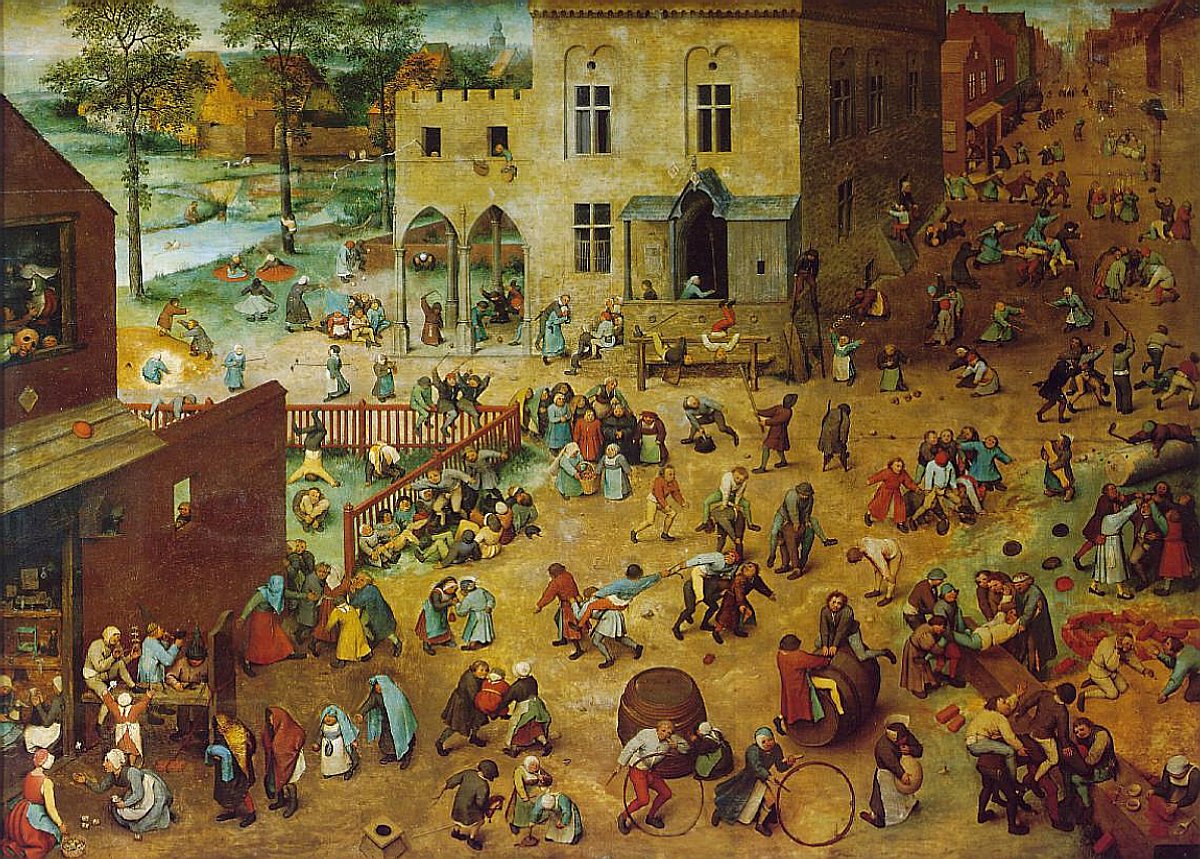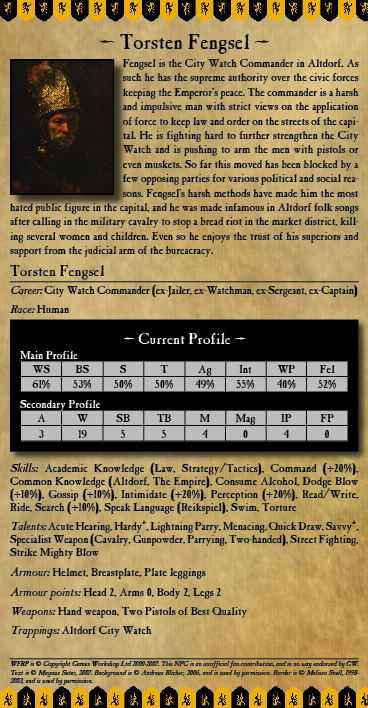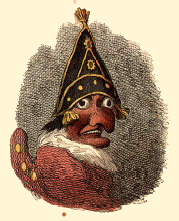I have now worked as a scribe at the Ratchett stables for several weeks. I find it immensely interesting as I often get a chance to speak to travellers going to and from our fair capital. It is also quite interesting to see how Gertrude Ratchett operates her coaching Empire, as I might call it. They transport people, of course, but also letters and special deliveries. I believe they have running contracts with some of the Merchant Houses of the Empire to act as a line of communication between important cities.
The Ratchett Stables seem to be a very serious business, certainly above the average quality found in other competing outfits of comparable size. The security they offer while on the road is fairly high, and Frau Ratchett has a well thought out contingency plan for horses becoming ill or dying, and five main coaching stations. There is quite a lot of administrative overhead, which is unusual for this kind of business, but I would be the last to complain as it gives me work and a steady wage. I also believe that the amount of paperwork put in by the formidable Frau Ratchett and her employees actually contributes to the relative success of the Ratchett line.
The Ratchett line only has four coaches. The main hub is in Altdorf, and the destinations are Middenheim, Nuln, Talabheim and Gisoreaux. Curiously Frau Ratchett has also aquired a station in all of the destinations. At each station there are spare horses (normally 4, but since more coaches use the Altdorf station, there are 20 horses here as well, so that the coaches can switch horses and quickly get back on the road). I was a bit overwhelmed at the amount of horses, but I soon learned that fresh and healthy horses is a vital ingredient in running a successful coaching line. Also, Frau Ratchett will rent out horses for use within the walls of Altdorf for short periods of time to raise additional income.
Each station has around the clock guards (2 at any give time), and the driver and coach guard are well trained and experienced. All guards and drivers have worked for the Ratchett Stables for a long time, and are tried and trusted, which is also a corner stone for the business. Frau Ratchett knows that her drivers will do their best, and she knows they won’t just dump any suspect cargo at first sight of an Imperial toll booth.
Adolphus Altdorfer
Nachexen 30, 2522 IC
Let’s look at the economics of a business like the one Adolphus describes above.
My calculations indicate that the cost of running the Ratchett Lines are around 26 000 Gold Crowns a year. This takes into account a reasonable level of safety for passengers, drivers and guards, as well as a reasonable administrative organisation to handle all the paperwork associated with the business. Most prices I based this on are pulled from OWA, except for items marked with a ”*”. All yearly prices are calculated using a 12 month year with 400 days.
I have assumed that a coach can travel 25 miles per day, and that the coaches are on the road 70% of the time.
This caluculation establishes the following price levels:
1 gc per 10 miles = 60% loss
3 gc per 10 miles = 25% profit
5 gc per 10 miles = 55% profit
7 gc per 10 miles = 200% profit
The OWA gives the price of 7 GC per 10 miles, but it is unclear as to whether this is for hiring one coach, or per passenger. When I did this calculation a year ago or so, I arrived at the conclusion that the price of 7 GC per 10 miles was for hiring an entire coach for yourself.
So the cost for one passenger would be around 1 gold crown and 10 shillings per 10 miles, or 3 shillings a mile, give or take a few pennies.
For those interested, I have broken down the costs associated with the Ratchett Lines.
Startup costs
Item / Cost per item in gc/ Quantity / Subtotal
Coaches / 500 / 4 / 2000
Horses / 25 / 36 / 900
Grooming kits / 5 / 36 / 180
Harness and special equipment / 2 / 32 / 64
Barding / 75 / 32 / 2400
Driver equipment (hand weapon, leather jack and cap, coach horn) / 35 / 4 / 140
Coach guard equipment (blunderbuss (x2), powder and shot, leather jack and cap) / 160 / 4 / 640
Coaching station in Altdorf / 2500 / 1 / 2500
Coaching station in Middenheim / 2000 / 1 / 2000
Coaching station in Nuln / 2000 / 1 / 2000
Coaching station in Talabheim / 2000 / 1 / 2000
Coaching station in Gisoreaux / 2500 / 1 / 2500
Station guard equipment (hand weapon, leather jack and cap, bell) / 30 / 30 / 900
Initial investment: 18224 gold crowns
Running costs (per year)
Item / Cost per item in gc per day / Quantity for the whole year / Subtotal
Horse fodder / 0,020833333 / 14400 / 300
*Horse shoeing and fitting / 1,125 / 36 / 40,5
Horse medicine / 117 / 1 / 117
Driver salaries (including double pay for risky work) / 234 / 4 / 936
*Driver training / 15 / 4 / 60
Coach guards salaries (including double pay for risky work) / 234 / 4 / 936
*Coach guard training / 15 / 4 / 60
Coaching stations (upkeep) / 150 / 5 / 750
1 senior clerk at each station / 117 / 5 / 585
2 junior clerks working at each station / 26 / 10 / 260
6 guards at each station (3-shift) / 78 / 30 / 2340
4 stable boys at each station / 15 / 20 / 300
Writing kits / 10 / 60 / 600
Paper (bookkeeping) / 0,25 / 4000 / 1000
*Posters (advertising) / 0,4 / 1000 / 400
*Medical expenses for drivers and coach guards / 50 / 8 / 400
Pensions for widows and orphans / 100 / 1 / 100
*License / 150 / 5 / 750
Mortgage and interest (5 year loan at 25%) / 4556 / 1 / 4556
Extraordinary expenses (10% of cost) / 1449,05 / 1 / 1449,05
Efficiency (per year)
Miles travelled per coach (with 30% downtime) 7000
Running costs with four passengers (per coach per mile)
Item / Cost per item in gc per mile / Subtotal
Tolls and fees / 0,056 / 0,056
Coaching inn for passengers (lodging, breakfast, lunch and dinner) / 0,1 / 0,1
Stabling (four horses) / 0,006666667 / 0,006666667
Coach upkeep / 0,05 / 0,05
Bribes and taxes
Twenty percent of real costs / 4378,843333 /
Running total: 26273,06 gc
Magnus









